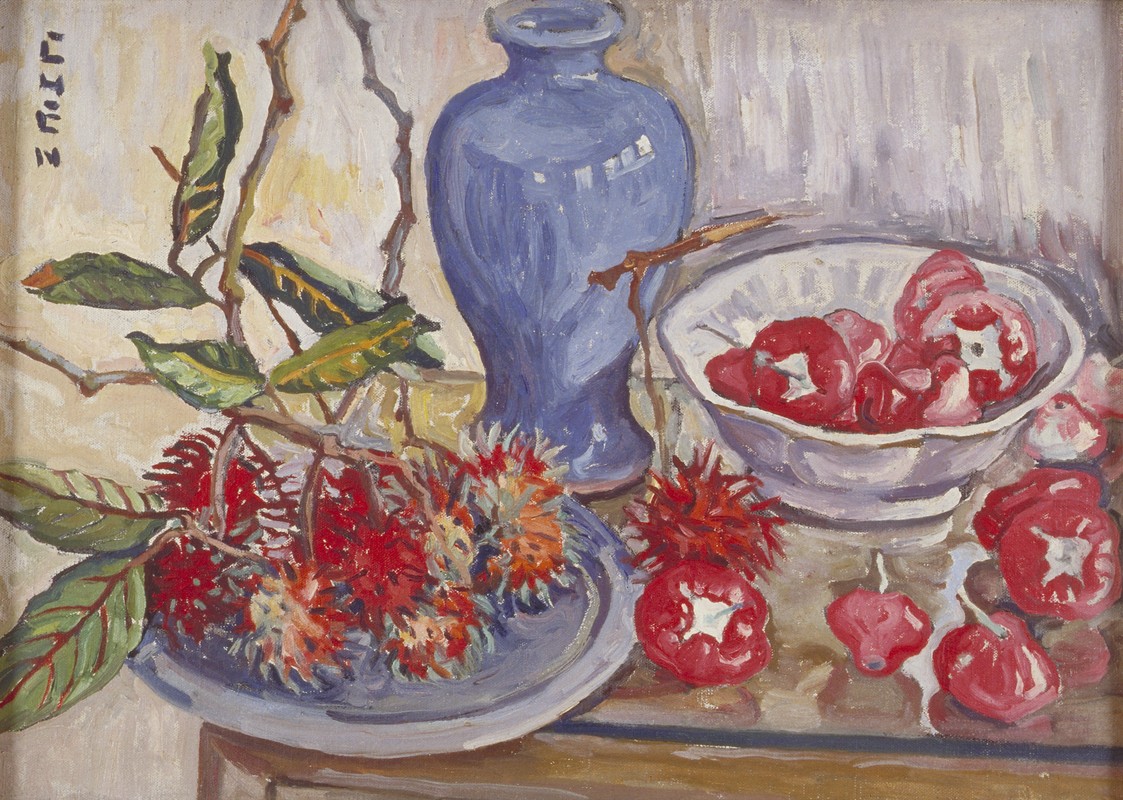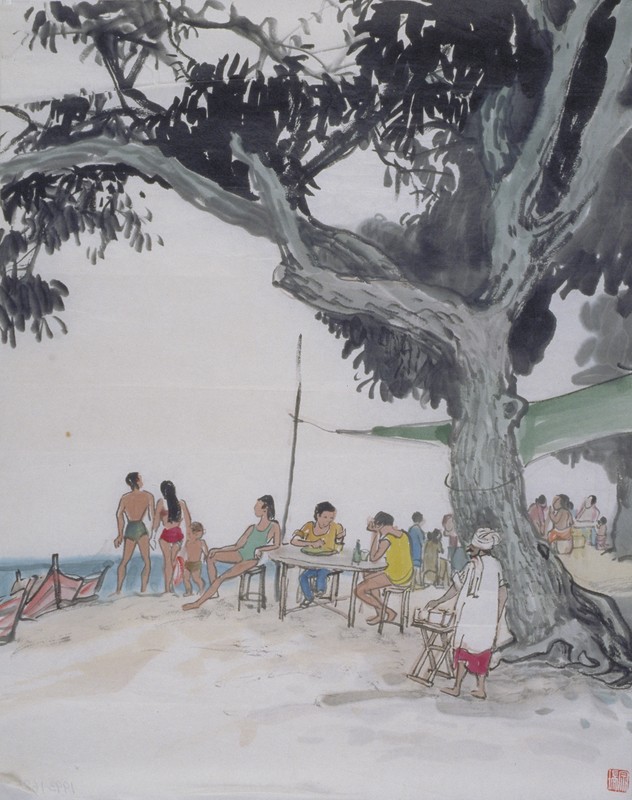‘Nanyang art’ by artists from China: Emergence of a local consciousness
In Southeast Asia, the term Nanyang (literally “South Seas”) usually refers to Singapore, Malaya, Indonesia, as well as the coastal region of Indochina. “Nanyang Chinese Literature” historically is a term often used to describe the experiences of the Chinese in Malaya. Despite apparent confusion and entanglements over such terms as “Nanyang (or Malayan) style or school”, Nanyang art simply means art created by artists from China who settled in Singapore and Malaya and formed social, economic and political interests in their adopted homeland in the 20th century.
Growing sense of place
The art scene of the 1930s saw an emerging local consciousness among artists from China, reflecting a growing sense of place as they became more firmly settled in Singapore. In fact, the change had earlier begun in the literary scene, where writers were addressing social issues of the time. In 1926, Duan Nankui (birth and death years unknown), editor of the literary supplement of Chinese newspaper Lat Pau, described local society in this way: “It is a hackneyed, degenerate, static, stagnant, cumbersome, indifferent and hemiplegic, sick society.” He urged the intelligentsia “to adopt a critical attitude in re-evaluating all the values in Nanyang”. Another editor, Xu Jie (1901–1993), wrote in 1928, in the 10th issue of Yik Khuan Poh’s literary supplement Kudao (Desert Island): “Nanyang has its own history, customs, human environment and landscape, our writers need not search far for what we can find around us as excellent material for literary writing … Literature requires local colour, for instance when we mention Nanyang coconut palms, tall trees, expansive countryside, cottages, and bullock carts readily come to mind and occupy our thoughts. If we can capture colours such as these and express them in our writing, it will be the best of literary writing.”
Beginning from the second half of the 1920s, there had arisen a greater awareness of “the peculiarity of the locale” in Malaya (Singapore included), affirming the value of local writing by refusing to be reduced to “a mere tributary of Chinese culture”. Such consciousness had a direct impact on the entire Chinese community. The Chinese newspapers of this period, such as Nanyang Siang Pau, started by Tan Kah Kee in 1923; and Sin Chew Jit Poh, started by Aw Boon Haw and his brother in 1929, were also actively engaged in the discussion on calling for wider attention to the importance of Nanyang literature.
According to reports in Nanyang Siang Pau and Sin Chew Jit Poh, 1931 was a fruitful year with a number of notable exhibitions. A new art group called Nan Sing Arts Association organised an exhibition of its members’ works and other works from various periods. A writer who called himself Waihan (“outsider”) commented on the exhibition, urging artists “to resist the misfortune of social ills with noble spirits”. After the exhibition, the organisers set up an art school, which also offered Chinese-language lessons in the evenings. The same year saw the Chang Chow Association (now Chang Chow General Association) present an exhibition of ancient paintings and calligraphy works from various dynasties. Poet and calligrapher Khoo Seok Wan’s (1874–1941) works were also featured.
In 1931, a special group called the Nanyang Journalistic Caricature Association was formed by artist Chen Shengping (1900s–1975), a graduate of the Shanghai Art University. Chen had then recently arrived in Singapore. His cartoon “Victim of the Wheel of Economy Today” that was printed in the Nanyang Students’ Society’s quarterly magazine in 1930 prompted Sin Chew Jit Poh to start running cartoons. He then became the editor of the features section of the newspaper for a short period, before leaving to dedicate himself to cartoon art in the Nanyang Journalistic Caricature Association. During the recruitment drive for the association, he wrote in the press: “Because of the shortage of cartoonists on this island, we specially offer cartooning courses both in classroom and through correspondence. Students can learn the technique of cartooning within a short time … With our pen we want to depict the hypocrisy of those who speak about virtue and righteousness but behave like robbers, and everything that is thoroughly evil and ugly.” By the end of 1931, the Association had published a book titled Shehui Manhua (Social Cartoons), which was a platform for cartoons as well as literary writing.
Formation of the Society of Chinese Artists
This appeared to usher in a yet more vibrant art scene during the second half of the 1930s, as artists and members of the intelligentsia arrived in increasing numbers due to the unstable political situation in China at that time. Many of them participated keenly in art activities, and some even formed art groups. Amid mounting tensions in 1936 and 1937 as the Second Sino-Japanese war drew near, artists sought to reflect the reality of the times by making art more relatable to the social conditions of the time. They also rallied like-minded people to form associations which promoted art.
One such group, comprising artists1 such as Cai Zhuzhen (1900s–1974), Li Yunyang, Lin Dao’an, Hsu Chunlin (1911–2000), Teo Peck Ho (1901–1957), Ling Tian, Chen Shengping, Liu Gongxi, Huang Cheng Chuan and Li Kueh Sei (1902–1971), proposed in April 1935 to form the Salon Art Association with the alumni of Shanghai Art Academy. However, the numbers fell short and another meeting2 was convened later in the year with Tchang Ju Chi (1904–1942), Chuang U-Chow (1907–1942), Teo Peck Ho, Lu Heng (1902–1961), Lai Wenji, Kau Chin Seng, Chen Chong Swee (1910–1985), Ling Tian and Hsu Chunlin, who then decided that membership should be open to those from Malaya and the Dutch East Indies. This led to the establishment of the Society of Chinese Artists in November 1935, which was formally registered in January the following year.
It became Singapore’s first visual arts organisation with a proper structure, with members responsible for a range of functions including publication. The first batch of office bearers included Tchang Ju Chi as president, Yong Mun Sen as vice-president, and other leading artists in various positions. The society planned to hold annual exhibitions, host visiting artists from abroad and invite them as special guest speakers. The Second Sino-Japanese War broke out in 1937, leading to an influx of Chinese artists and writers to Singapore. This enlarged the island’s cultural talent pool, and artistic standards went up. Works created at this time showed greater local content, while previous sojourner sentiments were much reduced.

The formation of the Society of Chinese Artists is particularly significant in the history of art education in Singapore. The society would be the precursor to the establishment of the Nanyang Academy of Fine Arts in 1938. Such a development was no accident because most of the society’s members were school teachers — for instance, Tchang Ju Chi, Teo Peck Ho and Chen Chong Swee of Tuan Mong School; Yeh Chi Wei (1913–1981) of Chung Cheng High School; and Wu Tsai Yen (1911–2001) and Yan Zaisheng (birth and death years unknown) of Tao Nan School.
Art coverage in newspapers
Apart from art associations and educational institutions, the media also played an important role. In the years leading up to the war, both Nanyang Siang Pau and Sin Chew Jit Poh devoted much space to the coverage of activities and discourse related to art issues, especially in their art supplement or features sections. In this respect, editor Dai Yinlang (1906–1985), who became the features editor of Art Today in Nanyang Siang Pau’s Sunday supplement in 1937, stood out as a staunch champion of the arts. Dai, a versatile artist himself who worked in woodcut and watercolour, offered a platform for artists to publish their artworks, especially woodcuts and cartoons; and for artists and writers to engage in dialogue. Under his editorship, which lasted only about half a year, 24 weekly issues of the supplement were published. They had an enduring impact on art development in pre-war Singapore.
In the 1930s, Koh Cheng Foo (also known as Ma Ge or Marco Hsu, 1908–1993), an art critic and the principal of Ai Tong School, wrote regularly about art in Singapore for Nanyang Siang Pau. These articles, published between 1933 and 1936, were later collected in 1950 into a book entitled Nanyang Zhi Mei (The Beauty of Nanyang). The book celebrated the art, life and people of Nanyang, and refuted the oft-repeated comment about Singapore being a cultural desert or backwater. Koh published more than a dozen books on art, the best-known being Malaiya Yishu Jianshi (A Brief History of Malayan Art) which came out in 1963. This book was translated in 1999 by Dr Lai Chee Kien and became an important reference to students of Singapore art history. Koh’s writings between 1950 and 1963 expanded the Nanyang art discourse by shifting its focus from the Nanyang as imagined by the Nanyang Chinese (signified by his use of the term Nanyang qundao, or “Nanyang as a group of islands”) to the Malayan School of Painting (Malaiya hua pai). The latter signified a Malayan culture unifying all races rather than a Nanyang culture only for the Chinese.

“Nanyang character” (Nanyang secai), something which had been much discussed in literary circles since the early 1930s, appeared in the visual arts for the first time in the work of Tchang Ju Chi. When Tchang arrived from China in 1927, he immediately became active in education and art in Singapore, and developed a close association with Chen Lien Tsing (1907–1943) — the chief editor of Chinese newspaper supplement Yelin (Coconut Grove), who was advocating “Nanyang character” in literature. Tchang consciously worked “Nanyang character” into his paintings, such as Mila Yu Renna (Mila and Renna) and Manzai’ergui (Returning Fruitful) from his journey to Sumatra in 1934. Between 1936 and 1941, he was the president of the Society of Chinese Artists and an oil painting lecturer at the Nanyang Academy of Fine Arts. The academy would be a fulcrum for the artistic community of Singapore and Malaya for most of the 20th century.
Then, the founding of Nanyang Academy of Fine Arts is to become another important milestone in Malayan art history.
| 1 | Birth and death years of several artists are unknown. |
| 2 | Birth and death years of several artists are unknown. |
Hsu, Marco, translated by Lai Chee Kien. A Brief History of Malayan Art. Singapore: Millennium Books, 1999. | |
Chung, Yi. Malaixiya huaren meishushi (1900–1965) [A history of Malaysian arts (1900–1965)]. Kuala Lumpur: Zheng Shan International Art Group, Malaysian Institute of Art Eastern Arts Research Centre, 1999. | |
Hsu, Marco. Nanyang zhimei [The beauty of Nanyang]. Singapore: Nanyang wenku, 1950. | |
Yeo, Song Nian. Zhanqian xinma wenxue bendi yishi de xingcheng yu fazhan [The birth and development of pre-war Chinese literary arts in Singapore and Malaya]. Singapore: NUS Department of Chinese Studies, World Scientific, 2001. |










